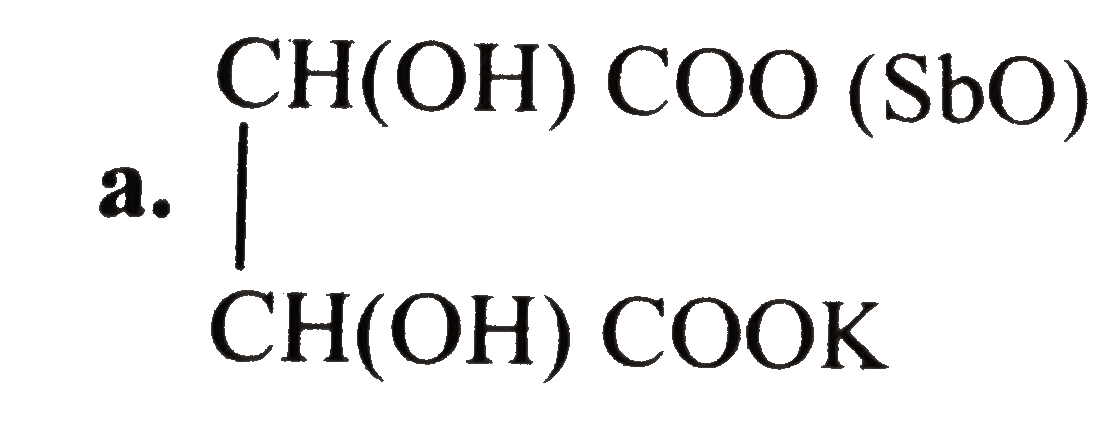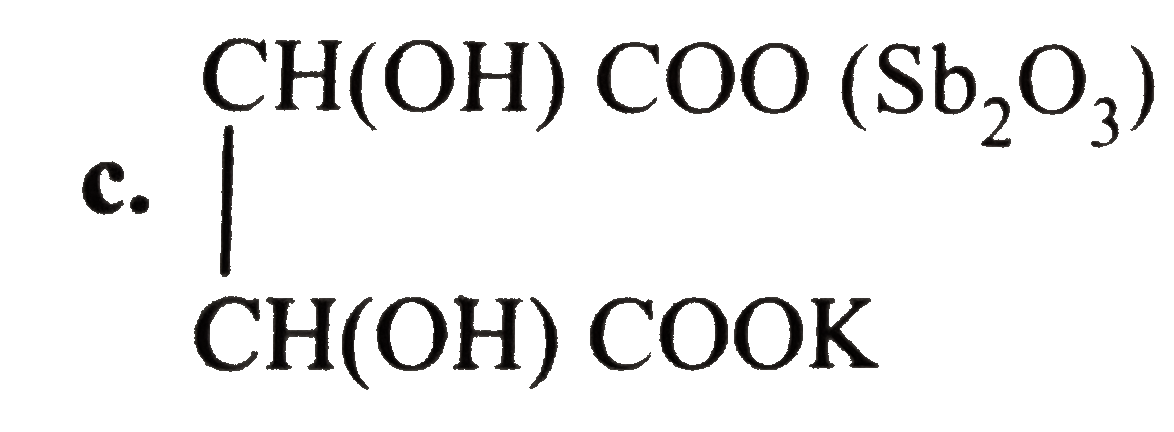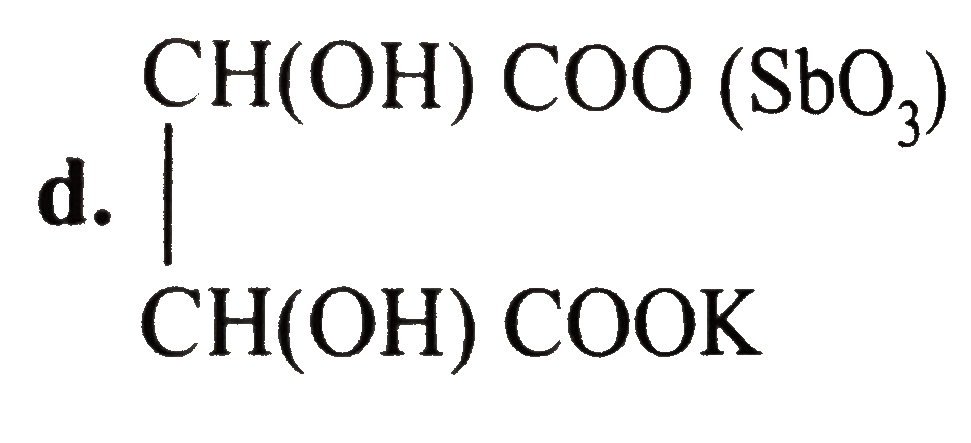Tartar emetic (potassium antimony tartrate) is used as an emitic in small does while larger does are poisnous. It is used for the treatment of Kala-azar and such other tropical diseases. It is formed when antimonytrioxide (Sb4O6) is treated with potassium hydrogen tartrate. It is.




The correct Answer is:A
Step by step video, text & image solution for Tartar emetic (potassium antimony tartrate) is used as an emitic in small does while larger does are poisnous. It is used for the treatment of Kala-azar and such other tropical diseases. It is formed when antimonytrioxide (Sb_4 O_6) is treated with potassium hydrogen tartrate. It is. by Chemistry experts to help you in doubts & scoring excellent marks in Class 12 exams.
Updated on:21/07/2023Topper's Solved these Questions
- P-BLOCK GROUP 15 ELEMENTS - THE NITROGEN FAMILYBOOK - CENGAGE CHEMISTRYCHAPTER - P-BLOCK GROUP 15 ELEMENTS - THE NITROGEN FAMILYEXERCISE - Exercises (Integer)
20 Videos
- P-BLOCK GROUP 15 ELEMENTS - THE NITROGEN FAMILYBOOK - CENGAGE CHEMISTRYCHAPTER - P-BLOCK GROUP 15 ELEMENTS - THE NITROGEN FAMILYEXERCISE - Exercises (Fill In The Blanks)
15 Videos
- P-BLOCK GROUP 15 ELEMENTS - THE NITROGEN FAMILYBOOK - CENGAGE CHEMISTRYCHAPTER - P-BLOCK GROUP 15 ELEMENTS - THE NITROGEN FAMILYEXERCISE - Exercises (Multiple Correct)
12 Videos
- ORGANIC COMPOUNDS WITH FUNCTIONAL GROUPBOOK - CENGAGE CHEMISTRYCHAPTER - ORGANIC COMPOUNDS WITH FUNCTIONAL GROUPEXERCISE - Archives Analytical And Descriptive
24 Videos
- P-BLOCK GROUP 16 ELEMENTS - THE OXYGEN FAMILYBOOK - CENGAGE CHEMISTRYCHAPTER - P-BLOCK GROUP 16 ELEMENTS - THE OXYGEN FAMILYEXERCISE - Archives Subjective
10 Videos
Similar Questions
The reagents like AgNO3,K4[fe(CN)6],KCNS,KI,K2CrO4 Nessler's ect, find extenstive and very important applicasion in quentitative analysis because these resgents form different type of produce with different cation for axample KI form yellow precipitate with Pb2+ but at form red iprecipitate with Hg2+ , Hence these reagents are widely used in the quantitative amalysis of morgenic salts
Which of the following cation (i.e. basic radicals) forms coloured (not white) percipitates with aqueous solution of potassium indide the precipitete does not dissolve is exiess og reagent?
View Solution
An experimental setup of verification of photoelectric effect is shown if Fig. The voltage across the electrodes is measured with the help of an ideal voltmeter, and which can be varied by moving jockey J on the potentiometer with wire. The battery used in potentiometer circuit is of 20 V and its internal resistance is 2Ω. The resistance of 100 cm long potentiometer wire is 8Ω.
The photocurrent is measured with the help of an ideal ammeter. Two plates of potassium oxide of area 50cm2 at separation 0.5mm are used in the vacuum tube. Photocurrent in the circuit is very small, so we can treat the potentiometer circuit as an independent circuit. The wavelength of various colors is as follows:
Q. When other light falls on the anode plate, the ammeter reading remains zero till jockey is moved from the end P to the middle point of the wire PQ. Thereafter, the deflection is recorded in the ammeter. The maximum kinetic energy of the emitted electron is
View Solution
Knowledge Check

An experimental setup of verification of photoelectric effect is shown if Fig. The voltage across the electrodes is measured with the help of an ideal voltmeter, and which can be varied by moving jockey J on the potentiometer with wire. The battery used in potentiometer circuit is of 20 V and its internal resistance is 2Ω. The resistance of 100 cm long potentiometer wire is 8Ω.
The photocurrent is measured with the help of an ideal ammeter. Two plates of potassium oxide of area 50cm2 at separation 0.5mm are used in the vacuum tube. Photocurrent in the circuit is very small, so we can treat the potentiometer circuit as an independent circuit. The wavelength of various colors is as follows:
Q. It is found that ammeter current remains unchanged (2μA) even when the jockey is moved from the end P to the middle point of the potentiometer wire. Assuming that all the incident photons eject electrons and the power of the light incident is 4×10−6 W. Then, the color of the incident light isAGreenBVioletCRedDOrangeIn iodometric titrations, an oxidizing agent such as KNnO4,K2Cr2O7,CuSO4,H2O2 is allowed to react in neutral medium or in acidic medium with excess of potassium iodide to liberate free iodine Kl+ oxidizon agent →l2
Free iodine is titrated against stanard reducing agent usually with sodium thiosulphate i.e.,
K2Cr2O7+6Kl+7H2SO4→Cr2(SO4)3+4K2SO4+7H2O+l2
2CuSO4+4Kl→Cu2l2+2K2SO4+l2
l2+Na2S2O3→2Nal+Na2S4O6
In iodometric titrations, starch solution is used as an indicator. Starch solution gives blue or violet colour with free iodine. At the end point, blue or violet colour disappear when iodine is completely changed to iodide.
A 1.1g sample of copper ore is dissovled and Cu2+ (aq.) is treated with Kl.l2 liberated required 12.12mL of 0.1MNa2S2O3 solution for titration. The %Cu in the ore in the ore is:A2.5%B7%C5.8%D4.2%Read the passage given below carefully and answer the s that follow :
1. Overpowering prey is a challenge for creatures that do not have limbs. Some species like Russell's viper injects poison. Some others opt for an alternative non-chemical method - rat snakes, for instance, catch and push their prey against the ground, while pythons use their muscle power to crush their prey to death. But snakes can't be neatly divided into poisonous and non-poisonous categories.
2. Even species listed as non-poisonous aren't completely free of poison. The common Sand Boa, for instance, produces secretions particularly poisonous to birds. So, the species doesn't take any chance - it crushes its prey and injects poison as an extra step.
3. Do vipers need poison powerful enough to kill hundreds of rats with just one drop? After all, they eat only one or two at a time.
4. While hunting, animals try their best to kill most efficiently while their prey use any trick to avoid becoming a meal, such as developing immunity against poison. For instance, Californian ground squirrels are resistant to Northern Pacific rattlesnake poison.
5. Competition with prey is not the only thing driving snakes to evolve more and more deadly poison. Snakes also struggle to avoid becoming prey themselves.
6. Some snake killers have partial immunity to poison. Famously, mongooses are highly resistant to cobra poison, and with their speed and agility, kill snakes fearlessly. It would be the death of cobras as a specie if they didn't evolve a more deadly poison to stop mongooses.
7. Poison has another important role. It's an extreme meat softener, specific enzymes break up the insides of the prey. Normally, a reptile depends on the sun's warm rays to aid digestion.
8. But I wonder if we cannot use venom in our favour. In remote parts of India, local hospitality often involves leather-tough meat. I chew and chew until my jaws ache. If I spit it out or refuse, our hosts would be offended, I swallow like python stuffing a deer, down its throat and hope I don't choke. If only I had poison.
What difficulty does the writer face when he is entertained in the remote parts of India ?AServed with leather tough meat which is difficult to chewBDid not like the way he was entertainedCHe was feeling home sickDAll the above
Colligative property measurement is one of the techniques used in the measurement of chemical quantities with reasonable accuracy.
If a 40.65 gm sample of K2SO4 and BaSO4 is dissolved in 900 gm of pure water to form a solution 'A' at 57∘C.Its vapours pressure is found to be 39.6 torr while vapour pressure of pure water at 57∘C is 40 torr. Density of solution A is 1.24g/ml.
In a different experiment when small amount of pure BaSO4 is mixed with water at 57∘C it gives the osomotic rise at 4.05×10−5 atm.
(R=0.082Lt.−atm/mol−K,K=39,Ba=137,S=32,O=16)
Percentage of K2SO4 in the sample is :
View SolutionColligative property measurement is one of the techniques used in the measurement of chemical quantities with reasonable accuracy.
If a 40.65 gm sample of K2SO4 and BaSO4 is dissolved in 900 gm of pure water to form a solution 'A' at 57∘C.Its vapours pressure is found to be 39.6 torr while vapour pressure of pure water at 57∘C is 40 torr. Density of solution A is 1.24g/ml.
In a different experiment when small amount of pure BaSO4 is mixed with water at 57∘C it gives the osomotic rise at 4.05×10−5 atm.
(R=0.082Lt.−atm/mol−K,K=39,Ba=137,S=32,O=16)
Solubility product of BaSO4 in water at 57∘C is :
View SolutionColligative property measurement is one of the techniques used in the measurement of chemical quantities with reasonable accuracy.
If a 40.65 gm sample of K2SO4 and BaSO4 is dissolved in 900 gm of pure water to form a solution 'A' at 57∘C.Its vapours pressure is found to be 39.6 torr while vapour pressure of pure water at 57∘C is 40 torr. Density of solution A is 1.24g/ml.
In a different experiment when small amount of pure BaSO4 is mixed with water at 57∘C it gives the osomotic rise at 4.05×10−5 atm.
(R=0.082Lt.−atm/mol−K,K=39,Ba=137,S=32,O=16)
Elevation in boiling point of solution A is (Kbwater=0.54K−kg/mol):
View SolutionColligative property measurement is one of the techniques used in the measurement of chemical quantities with reasonable accuracy.
If a 40.65 gm sample of K2SO4 and BaSO4 is dissolved in 900 gm of pure water to form a solution 'A' at 57∘C.Its vapours pressure is found to be 39.6 torr while vapour pressure of pure water at 57∘C is 40 torr. Density of solution A is 1.24g/ml.
In a different experiment when small amount of pure BaSO4 is mixed with water at 57∘C it gives the osomotic rise at 4.05×10−5 atm.
(R=0.082Lt.−atm/mol−K,K=39,Ba=137,S=32,O=16)
Concentration of Ba2+ ions in solution 'A' is :
View SolutionWhen an aqueous solution of a colourless mixture of two salts is treated with a drop of chlorine water, the solution becomes brown. Some chloroform is added to the brown solution and the resulting mixture is shaken wel. The chloroform layer becomes violet.
(ii) When chlorine water is again added dropwise to the above mixture, the chloroform layer becomes colourless.
(iii) On being heated with solid K2Cr2O7 and concentrated H2SO4, the solid mixture gives vapours of a dark colour which form a yellow solution with aqueous NaOH. On acidification with acetic acid followed by treatment with lead acetate, the yellow solution gives a yellow precipitate.
(iv) When boiled with an NaOH solution, the mixture gives a gas that produces thick white fumes with HCl vapours and turns nessler's reagent brown. the mixture does not respond to any other test for cations.
(v) The mixture, on being heated, gets completely sublimed.
Q. What is the oxidation sate of the central atom in the anion constituting the yellow precipitate obtained in (iii)?
View Solution
